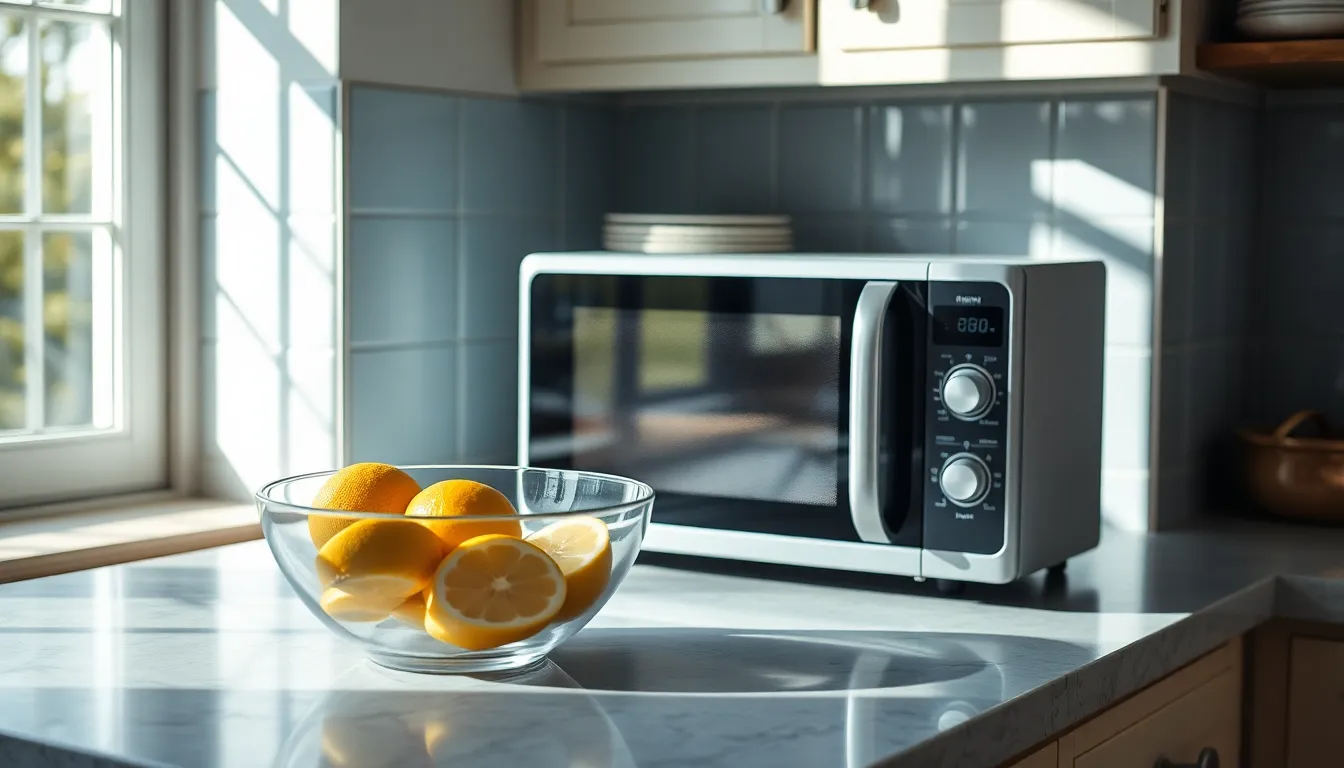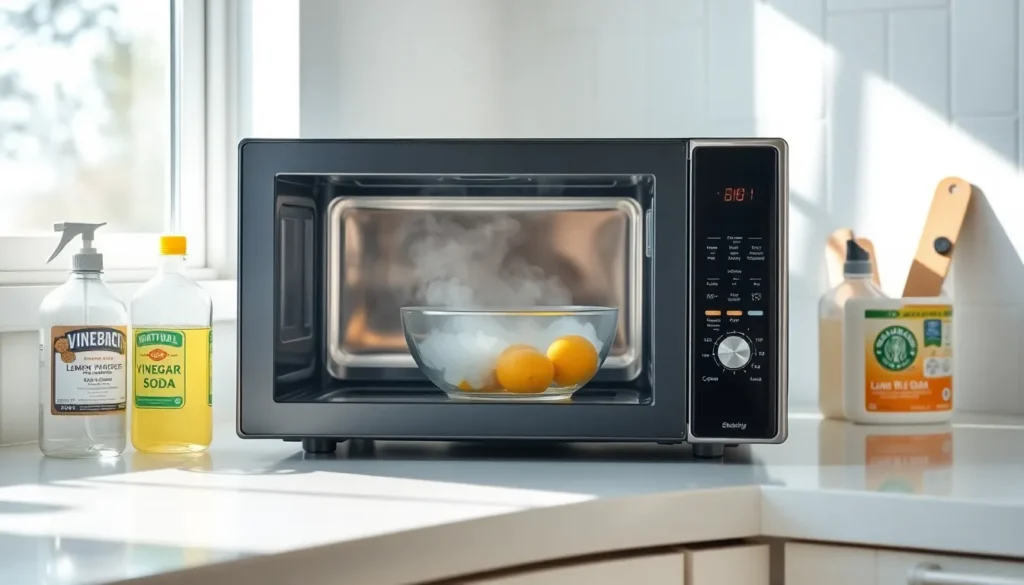Table of Contents
ToggleMicrowaves are the unsung heroes of the kitchen, zapping leftovers and reheating last night’s pizza in mere minutes. But let’s face it, they can also become a battlefield of splatters and spills, leaving behind a mess that’s less than appetizing. Who knew a simple meal could turn into a science experiment?
What Is Microwave Cleaning?
Microwave cleaning refers to the process of using steam and simple solutions to eliminate food residues and odors from microwave interiors. This method allows for efficient cleanup without harsh chemicals. Using common household items like water, vinegar, or lemon juice, individuals can create steam that loosens stubborn grime.
Steam cleaning works effectively by placing a bowl filled with water and one of the solutions inside the microwave. Heating the mixture for several minutes creates steam, which softens any stuck particles. Once the cycle ends, wiping down the interior with a clean cloth becomes easier.
Many prefer this approach due to its simplicity and the minimal need for scrubbing. Some products, such as microwave-safe cleaning containers, are designed specifically for this purpose. Utilizing these containers can enhance effectiveness and convenience during the cleaning process.
Cleaning involves several steps. First, prepare a cleaning solution by mixing water with vinegar or lemon juice. Next, place the mixture in the microwave and heat for about five to ten minutes. Finally, remove the bowl carefully and wipe down all interior surfaces with a cloth or sponge.
Regular maintenance prevents buildup, making future cleaning quick and easy. Using this technique also helps in reducing the chances of lingering odors, contributing to a fresher kitchen environment. Overall, microwave cleaning serves as an essential practice for maintaining kitchen appliances and ensuring hygienic food preparation.
Benefits of Microwave Cleaning

Microwave cleaning offers multiple advantages, making it an essential skill for every kitchen. It streamlines the cleaning process, promotes eco-friendliness, and enhances overall hygiene.
Time Efficiency
Time efficiency stands out as one of the primary benefits of microwave cleaning. It significantly reduces the time spent scrubbing and scraping food residues. Many users complete the entire cleaning process in under 10 minutes. Simply filling a microwave-safe bowl with water, vinegar, or lemon juice, heating it for a few minutes, and wiping down surfaces makes for an easy task. Steam generated during this process helps loosen grime effortlessly. Regular maintenance ensures a clean working environment, preventing stubborn spills and saving even more time in the kitchen.
Eco-Friendly Options
Eco-friendly options play a crucial role in microwave cleaning. Individuals can utilize natural ingredients, avoiding harsh chemicals that often harm the environment. Vinegar and lemon juice serve as effective cleansing agents, breaking down residues while leaving behind pleasant scents. These options also pose no risk to food safety, ensuring a cleaner microwave without harmful residues. Choosing eco-friendly methods helps reduce chemical usage, contributing to a healthier kitchen atmosphere. Incorporating natural elements into microwave cleaning promotes sustainable kitchen practices that benefit both users and the planet.
How to Effectively Clean Your Microwave
Cleaning the microwave doesn’t require a lot of effort. Following simple methods ensures a clean and fresh appliance.
Basic Cleaning Techniques
Start by filling a microwave-safe bowl with one cup of water and adding a few tablespoons of vinegar or lemon juice. Place the bowl in the microwave and heat it on high for five minutes. The steam produced loosens food particles, making them easier to wipe away. After the timer goes off, carefully remove the bowl and use a damp sponge or cloth to clean the interior surfaces. Pay attention to stubborn spots, which may require a little extra scrubbing. Wipe down the turntable and any removable parts, ensuring they’re free of residue. Regular cleaning prevents the buildup of grime and odors, keeping the microwave functioning well.
Advanced Cleaning Tips
For tougher stains, a baking soda paste can work wonders. Mix water with baking soda to create a paste and apply it directly to the affected areas. Let it sit for a few minutes, allowing the baking soda to break down the stains. Afterward, use a damp cloth for easy removal. Alternatively, using essential oils can enhance cleaning. A few drops of lemon or tea tree oil mixed with water can freshen the microwave while providing antibacterial properties. Keeping the microwave’s exterior clean is equally important; a simple wipe with a microfiber cloth and mild cleaner maintains its appearance. Utilizing these techniques helps maintain a hygienic and efficient kitchen environment.
Common Mistakes to Avoid
One common mistake involves neglecting to cover food when microwaving it. Without a cover, steam escapes, causing spills and splatters. Users should avoid using metal containers or utensils inside the microwave. Metal can cause sparks and potential fire hazards.
Another frequent oversight is failing to test the effectiveness of cleaning solutions. Users often assume all natural ingredients work equally well. For best results, he or she should prioritize vinegar or lemon juice, both proven to combat stubborn grime.
Many individuals overlook the importance of regular cleaning. Buildup occurs quickly if maintenance isn’t routine, leading to persistent odors and stuck-on food. Waiting until the microwave is visibly dirty contributes to more extensive cleaning efforts.
Using an incorrect heating time represents a significant error. Microwaving cleaning solutions for too long can cause bubbling over or splattering. He or she needs to monitor the cleaning process carefully, stopping when enough steam has formed.
Skipping the final wipe-down is also a common mistake. Leaving residue behind can lead to ongoing odors and dirtiness. Completing the cleaning by wiping down surfaces with a cloth ensures a clean finish and reduces future mess.
Lastly, ignoring exterior cleaning makes the microwave look unkempt. Smudges and spills accumulate on handles and surfaces, detracting from a tidy kitchen. Maintaining both the interior and exterior contributes to the appliance’s longevity and overall hygiene.
Maintaining a clean microwave is vital for a hygienic kitchen. By adopting simple cleaning techniques that utilize steam and natural ingredients, users can tackle stubborn grime effortlessly. Regular maintenance not only enhances the appliance’s efficiency but also promotes a healthier cooking environment.
Embracing eco-friendly cleaning solutions like vinegar and lemon juice helps avoid harsh chemicals while leaving the microwave smelling fresh. With just a few minutes of effort, anyone can ensure their microwave remains a convenient and clean tool for meal preparation. Prioritizing microwave cleanliness ultimately contributes to a more enjoyable and safe cooking experience.







